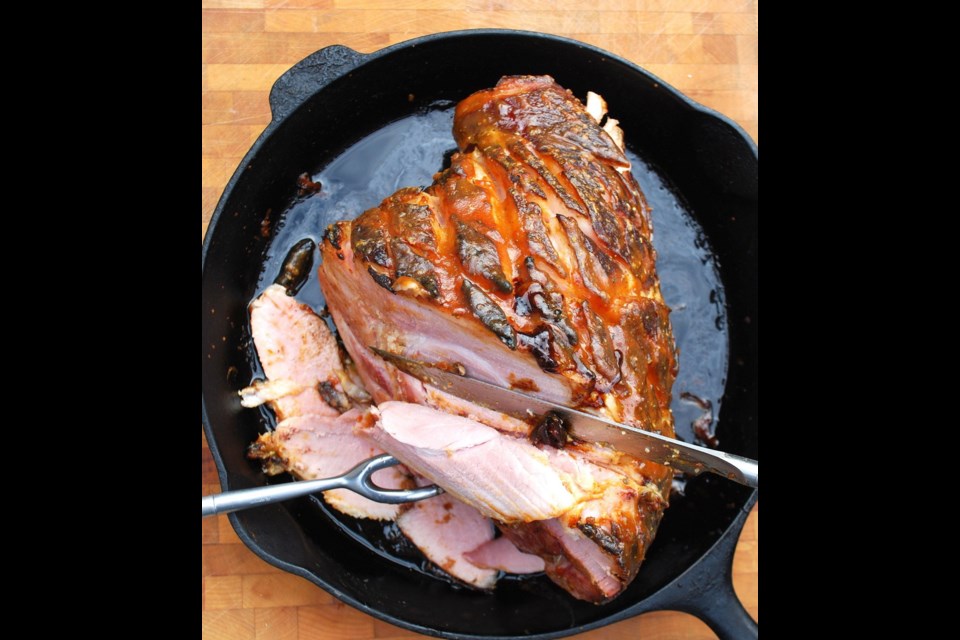Many folks often serve a big and succulent ham on a special occasion, such as Easter, and I was one of them. But one hot summer day a few years ago, when I had invited family over for a casual supper, that changed.
Because of the weather, I decided the main dish should be cooked on the barbecue, but I wanted to do something a little different, a.k.a. not burgers.
While in the grocery store deciding what that should be, I saw bone-in hams in the meat department. Cooking up one of those would be an easy way to feed a crowd, I thought, but it would mean I would heat up the house when I baked that ham in the oven.
But I quickly remembered that I often cook large whole chickens and roasts on the barbecue; surely I could cook a big ham there, too. So I did. It was easy to do, it was marvelous and I’ve published a recipe for it below.
Just to remind you, ham comes from the back leg of the pig. In supermarkets, that ham is most often cut and sold cut in shank portions, the lower part of the leg (what’s shown in today’s photo), and the hip or butt portions, the upper part of the leg. You can use either cut for today’s recipe.
Those portions of hams are also sold fully cooked. So all you’re really doing when cooking the ham on the barbecue is richening its exterior colour and heating through, about 140F or above when tested in the very centre with meat thermometer.
To cook a ham on the barbecue, I first place it in a barbecue-safe cooking pan. Once the barbecue is heated, I’ll set the pan with the ham in it on one side of the barbecue. I’ll then turn the heat off on that side and adjust the flame on the other side until the temperature in the chamber with the lid closed is about 375 F.
This indirect-heat method of cooking turns your barbecue into sort of a convection oven. Heat will rise up on one side of the barbecue, hit the lid and swirl around and over the ham, tastily heating it up without flames directly touching the pan and scorching the meat from below.
Later on in the cooking process, I brush the ham with a honey-mustard mixture, richly glazing it. When the ham is ready, I let it rest 10 minutes before slicing and serving.
Sometimes, I’ll serve that ham with corn on the cob, condiments, such as pickles, chutneys and mustards, and a selection of salads, such as today’s red cabbage kale slaw recipe.
At other times, I’ll serve the sliced ham with buns, pickles, mayonnaise, mustard and toppings, such as lettuce and sliced Swiss cheese, and let diners build their own ham bunwiches.
Today’s slaw recipe is also something you could sandwich in the buns with the ham, or simply serve alongside.
Barbecued Ham with Honey, Mustard and Sage
This easy-to-make summer entrée sees succulent ham cooked on the barbecue with a sweet and spicy glaze.
Preparation time: 10 minutes
Cooking time: 95 minutes
Makes: Eight to 10 servings
1 (8 to 9 lb./ 3.6 to 4 kg) bone-in, shank or butt portion ham
1 cup unsweetened apple juice
1/4 cup honey
3 Tbsp Dijon mustard
1 tsp chopped dried sage leaves (see Note)
1/2 tsp paprika
Preheat barbecue to medium-high, about 375 F in the chamber. Score top of the ham in a diamond pattern, making shallow cuts about one inch apart. Set ham, scored-side-up, in a large cast-iron skillet or other sturdy, shallow-sided pan suitable for the barbecue. Pour juice into the pan.
Loosely cover ham with aluminum foil and set on one side of the barbecue. Turn heat off underneath the ham; leave the other side of the barbecue set to medium-high, adjusting the heat as needed to maintain 375 F. Close the lid and cook the ham 60 minutes.
Make the glaze by combining honey, mustard, sage and paprika in a small bowl.
After the ham has cooked 60 minutes, remove the foil and brush with third of the glaze. Close the lid and cook the ham, not covered with foil, for 15 minutes. Brush with third more of the glaze and cook 15 minutes more.
Brush ham with the remaining glaze and heat through 10 minutes. Remove ham from the barbecue, tent with foil and rest 10 minutes, before slicing and serving.
Note: Dried sage leaves are sold in bottles at most supermarkets and is made from crumbled sage leaves. Don’t confuse it with powder-like ground sage.
Red Cabbage and Kale Slaw with Pumpkin Seeds and Raisins
This colourful slaw has an earthy taste that complements the smoky, rich-tasting ham. You can ready the dressing and the slaw ingredients a few hours before serving. Refrigerate separately until ready to toss together and serve.
Preparation time: 10 minutes
Cooking time: None
Makes: Eight to 10 servings
For the dressing
3 Tbsp cider vinegar
2 Tbsp unsweetened apple juice
2 Tbsp vegetable oil
1 Tbsp honey
2 tsp Dijon mustard
• salt and freshly ground black pepper to taste
For the slaw
3 cups finely shredded, packed cabbage (about 1Ú2 small head)
1 1/2 cup chopped, packed kale leaves (see Note)
1 medium to large celery rib, thinly sliced
1/2 cup coarsely grated carrot
3 green onions, thinly sliced
1/3 cup roasted, unsalted pumpkin seeds (see Note)
1/3 cup golden raisins
Make dressing by placing its ingredients in a jar and shaking well. Place slaw ingredients in a salad bowl, add dressing, toss to combine and serve.
Note: The kale was chopped into fairly small, about 1Ú2-inch wide pieces. Roasted pumpkin seeds are sold in the bulk-foods department of grocery stores and at bulk-food stores.
Eric Akis is the author of eight cookbooks. His columns appear in the Life section Wednesday and Sunday.



